G4 Insights has debuted a new technology to convert forest waste into renewable natural gas in Auburn, California. The process converts scraps and small trees from forest thinning projects into biomethane. In it first demonstration, G4 used gas produced onsite to fuel an unmodified Placer County truck.
 “G4 is pleased to have the opportunity to partner with Placer County, California Energy Commission, Southern California Gas Company, and U.S. Endowment for Forestry and Communities to make this project a great success,” said G4 Principal Matt Babicki. “This project demonstrates the potential for G4 PyroCatalytic Hydrogenation technology to transform forestry waste into high value, low carbon fuel, and support forestry communities with long term jobs to collect biomass and operate G4 renewable natural gas plants.”
“G4 is pleased to have the opportunity to partner with Placer County, California Energy Commission, Southern California Gas Company, and U.S. Endowment for Forestry and Communities to make this project a great success,” said G4 Principal Matt Babicki. “This project demonstrates the potential for G4 PyroCatalytic Hydrogenation technology to transform forestry waste into high value, low carbon fuel, and support forestry communities with long term jobs to collect biomass and operate G4 renewable natural gas plants.”
Typically, forestry waste is burned where trees are felled to reduce wildfire hazards, increasing local air pollution. Converting the forestry residues it into natural gas instead would reduce air pollution and increase the supply renewable energy. In the Foresthill area of Placer County alone, there are an estimated 20,640 tons of forestry waste produced each year – enough to fuel 4,926 cars for a year. A single ton of forestry waste could produce enough natural gas to drive from Lake Tahoe to Anchorage, Alaska. In the United States, there is enough current available and sustainable tree thinning and forestry industry waste to fuel more than 40,000 natural gas fleets the size of Placer County’s.
“Forest waste is one of the largest sources of potential waste resources for biofuels and bioenergy in California,” said California Energy Commissioner Janea A. Scott. “Bringing more technologies like the G-4 Insight technology, which can sustainably convert waste materials from forest restoration activities into low carbon transportation fuels online, would be a significant achievement.”
The G4 technology uses raw, untreated forestry waste that otherwise has no commercial use. Competing technologies require clean wood chips, stripped of bark, from harvested trees that could be used for other purposes. The gas it produces is of the same quality as conventional gas, and can be used for any of its purposes. G4 says the natural gas gthey produce using this technology reduces fossil emissions by 86 percent compared to standard gasoline.

